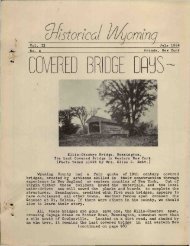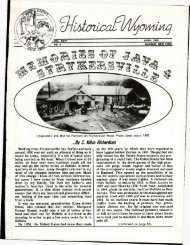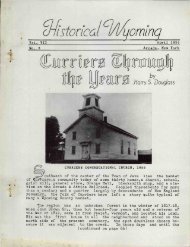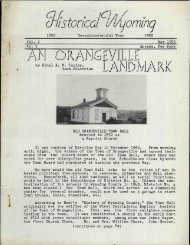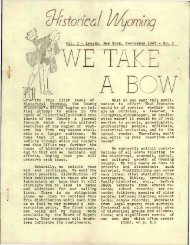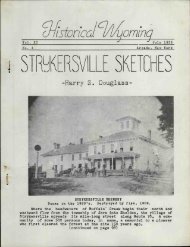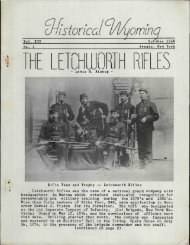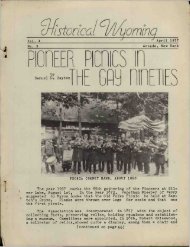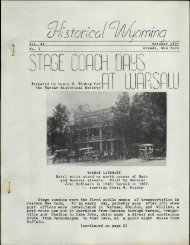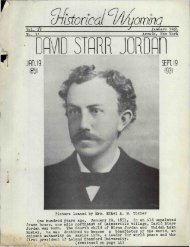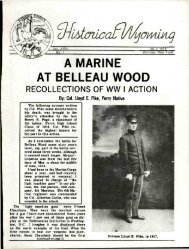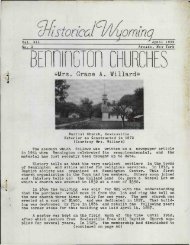Historical Wyoming County Jan 1980 - Old Fulton History
Historical Wyoming County Jan 1980 - Old Fulton History
Historical Wyoming County Jan 1980 - Old Fulton History
You also want an ePaper? Increase the reach of your titles
YUMPU automatically turns print PDFs into web optimized ePapers that Google loves.
JANUARY <strong>1980</strong> PAGE 61<br />
(The Warners Cont.)<br />
from the front and back of this room near the<br />
north end.<br />
"At the south end of the kitchen there was a<br />
large brick fireplace with a brick oven at the<br />
west side of it in which all of the baking used<br />
to be done; but after 1850 it was seldom used,<br />
as stoves were common and were considered<br />
more convenient. The fireplace was used for<br />
ten years or more for sugaring off the maple<br />
syrup.<br />
"Sometimes after the house was built, a room<br />
about 10 by 16 feet was added to the south end<br />
of the kitchen for the use of Great Grandfather<br />
Omri Warner's widow, who died about 1856, and<br />
that was my room from '56 as long as I lived<br />
at home. In the north and south ends of the<br />
main building there was a chimney with fireplaces<br />
on the lower and upper floors. . . .<br />
Open fireplaces seem pleasant in the evenings<br />
when it is not very cold, but are not comfortable<br />
in real cold weather.<br />
"Just east of the north end of the house was<br />
a building about 20 feet square used as a milk<br />
and cheese room. This was clapboarded and<br />
plastered. There were shelves on the east<br />
and west side and a double tier through the<br />
middle. At the south end of the wing there<br />
was a building about 16 by 40 feet running<br />
east, one and a half story. The lower part<br />
was open on the south side and was used for<br />
storing the winter's wood fuel, the upper part<br />
for storage.<br />
"Soon after the house was built a number<br />
of maple trees were set out in front of it. About<br />
1870, these had become so large they were<br />
cramped in growth and more than half of them<br />
were cut. Father had one of them sawed into<br />
lumber and he had some light stands made as<br />
souvenirs, one of which I still have." In after<br />
years these trees suggested the name for<br />
"Shadow Nook", a name which was applied<br />
to the large homestead erected in 1880 by<br />
Cordelia Warner Morrill, daughter of Milo.<br />
The place still stands.<br />
C.O. Warner, writing many years later about<br />
the cabin and frame home, wrote that the<br />
original large fireplace had no jams and was<br />
large enough for a back-log and a forestick<br />
with brands between. In the cold corner, by<br />
the shop door, was the place where the oldest<br />
child usually sat and the warmest spot, at the<br />
end of the fireplace where the dye tub was<br />
usually, became the seat for the younger<br />
children. The large smooth hearth-stone had<br />
a little cavity that was the best place on earth<br />
for cracking butternuts. Also the stone had another<br />
deeper hole where the cat used to lap<br />
up its milk. Never did the puss find such conveniences<br />
in the newer frame house! Even<br />
the cat-hole had vanished!<br />
The Warner's House<br />
The stick chimney had a great trammel pole<br />
high above the blaze with its array of hooks,<br />
big and little, supporting one above the other,<br />
pots, dish kettle, and tea kettle. Warner remembers<br />
the long stout string that was let<br />
down occasionally on a Sunday morning and a<br />
great spare rib attached to it to spew and<br />
frizzle as you turned it all day till the parents<br />
got home from meeting. Then there were poles<br />
above that groaned with the weight of drying<br />
apples and pumpkins. What a place to dry<br />
sausages above the door! The old shop contained<br />
the warping bars, the noisy quill wheel,<br />
the little wheel and the great wheel, and the<br />
loom where mother spun the threads for the<br />
family's garments.<br />
Milo's fifth child and second son, Philetus,<br />
had two goslings given to him when he was<br />
a small child and he thought a great deal of<br />
them. When a traveling preacher offered to<br />
trade (in jest) his watch for them, the boy<br />
thought it not a fair deal since the goslings<br />
were a good deal bigger than the watch! A year<br />
later when the goslings grew up, they proved<br />
to be both ganders and very pugnacious and<br />
quarrelsome and once pitched upon the boy and<br />
bit him and whipped him with their wings. Luckily<br />
someone drove them off. The next time the parson<br />
came around, the boy was willing to trade<br />
for the watch. They were a terror to the cows<br />
and fought one another till neither could stand.<br />
They would catch a cow by the tail and compel<br />
the animal to drag them, but when the animal<br />
would stop from weariness, the ganders would<br />
strike them with their wings to drive them on.<br />
During the early years the family had a sled<br />
that they went to church on; made of two<br />
stoneboat planks about a foot wide, held in place<br />
the proper distance and apart by pieces of wood<br />
pinned with wooden pins across, and a box to<br />
sit on and drawn by a pair of oxen. Such a sled<br />
was drawn easily over snow or mud, but not<br />
on the dry ground. Such a conveyance was not<br />
(continued on page 62)



